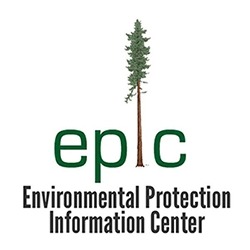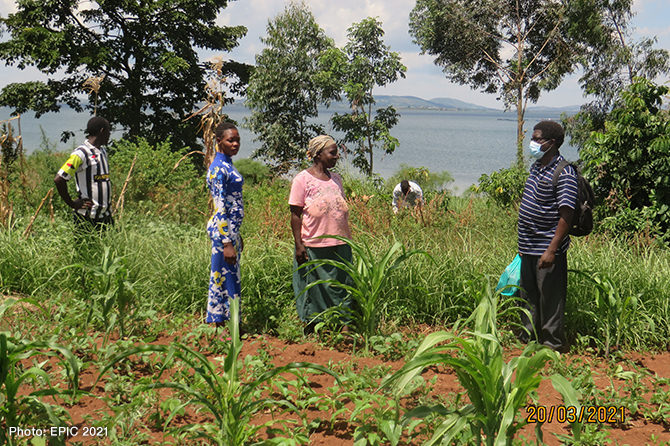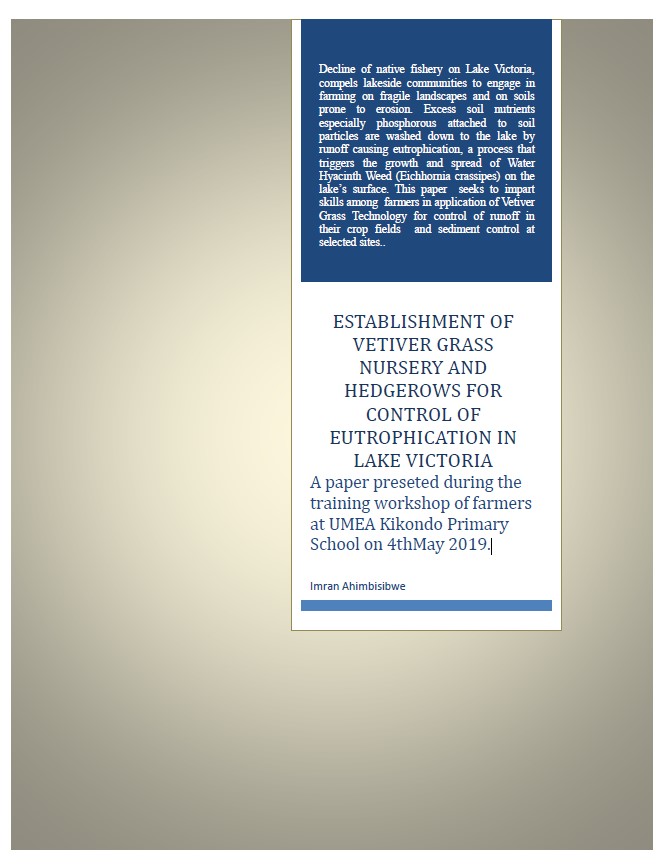2018 UGANDA
Establishment of Vetiver Grass Nursery and Hedgerows for control of Eutrophication in Lake Victoria
Environmental Protection Information Centre (EPIC)
Community / field-based implementation
Landscape
Overview
Communities in the project site, Buikwe and Jinja Districts, Uganda, depend on Lake Victoria as the source of their foods and livelihoods. Lake Victoria basin receives mean annual rainfall of 1500 mm which supports production of coffee, bananas, sweet potato, maize, sugar cane, tea and beans among others, providing goods for the communities. However, contamination of the lake has become a socio-environmental issue. Soil nutrients especially phosphorus from unprotected crop fields flow into the lake causing eutrophication. This has triggered the growth and spread of water hyacinth weed on the lake’s surface. This weed forms a dense mat, blocking sunlight for organisms below, depleting the low concentrations of oxygen and trapping fishing boats and nets of all sizes. It is also a breeding place for mosquitoes and snails.
In response to such issues, we aimed to address lack of awareness among local population and policymakers, as well as limited resources to combat the issues. Our objectives were:
1. Train farmers and village-based trainers in soil erosion control measures, in particular application of Vetiver Grass Technology (VGT).
2. Establish a Vetiver grass nursery for the community.
3. Support farmers with extension services.
Although the activities were hampered by the outbreak of COVID-19 and the related restrictions imposed by the state at the beginning of 2020, we achieved the following activities and outputs:
- Established 2 ha of Vetiver grass nursery in 2019, with the capacity of producing 6,000,000 slips per harvest that serves as a source of plant material for the entire community in the project area
- Provided training for 50 Village-Based Trainers and lead farmers who disseminate the knowledge and technique about application of VGT to other farmers during and after the project.
- Conducted 5 one-day training workshops about VGT, organized by the project for farmers and Village-Based Trainers.
- Procured 62,500 slips of Vetiver grass for the community nursery.
- Acquired and distributed nursery tools and equipment
- Due to COVID-19 outbreak and subsequent lockdowns, only about 30% of clumps of Vetiver slips from the community nursery was distributed to farmers and landing sites.
- Local authorities offered 3 ha of public land to the project for community nursery which is currently located on private land belonging to one of the farmers.
Key achievements
- At Wanyange landing site on Lake Victoria in Uganda, 90% of sediment and pollution that used to flow into the lake is now blocked substantially by a barrier made from Vetiver grass, and in the process a natural terrace has been created. Sediment is levelling the ground behind the Vetiver hedgerow.
- Water hyacinth weed has retreated from the shoreline. The water is now cleaner and clearer than before the introduction of Vetiver grass hedgerows.
- The fisher folks and the entire fishing village appreciated the services of this nature-based solution, (VGT). The initiative created awareness on dangers associated with water hyacinth weed and on the significance of VGT as a remedy.
- Lakeside farmers adopted VGT as a measure to control farm soil erosion, which enhances climate change resilience through increased soil nutrients and moisture retention levels.
Lessons
- Nature-based solutions are suitable and more effective for watershed protection than conventional grey technology because VGT is sustainable in terms of maintenance. It is durable, affordable to all farmers, easy to apply and cost-effective. This type of community-driven innovation can make concrete changes on the ground, both in farmers’ crop fields and on landing sites.
- During dry spells, the best time for watering seedlings in the nursery is at sunset or late in the evening. Moisture is retained in the nursery for a longer period of time throughout the cool nights than during the hot daytime.
- The input of local leaders in selection of trainees is critical to dissemination of granted knowledge and skills in target communities, since leaders know more about the abilities, attitudes and behavior of people in their areas. However, there is a concern they may use nepotism to select or favour their own relatives or friends. The selection list therefore should be verified and confirmed by the training organizers.
Project location
Organisation

Environmental Protection Information Centre (EPIC)
- Sector
- Non-governmental organisation
- Country
- Uganda
Related products
ESTABLISHMENT OF VETIVER GRASS NURSERY AND HEDGEROWS FOR CONTROL OF EUTROPHICATION IN LAKE VICTORIA
- Publisher
- Environmental Protection Information Centre (EPIC)
Decline of native fishery on Lake Victoria, compels lakeside communities to engage in farming on fragile landscapes and on soils prone to erosion. Excess soil nutrients especially phosphorous attached to soil particles are washed down to the lake by runoff causing eutrophication, a process that triggers the growth and spread of Water Hyacinth Weed (Eichhornia crassipes) on the lake’s surface. This paper seeks to impart skills among farmers in application of Vetiver Grass Technology for control of runoff in their crop fields and sediment control at selected sites. A paper preseted during the training workshop of farmers at UMEA Kikondo Primary School on 4th May 2019.
Relevant projects
Projects of the same year
Aichi Biodiversity Targets
Aichi Biodiversity Targets
-
Awareness increased
-
Sustainable agriculture, aquaculture and forestry
-
Pollution reduced
-
Invasive alien species prevented and controlled
Sustainable Development Goals
Sustainable Development Goals
-
Zero hunger
-
Responsible consumption, production
-
Life on land



